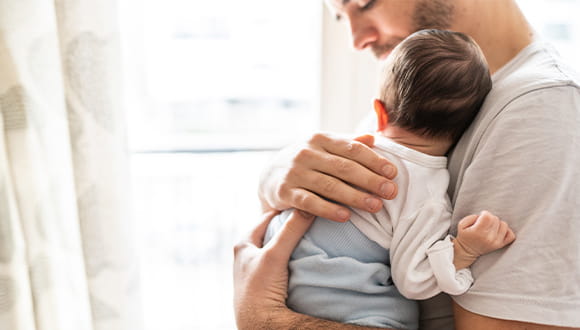One of the most persistent and pernicious myths disseminated online holds that the COVID-19 vaccine can cause infertility. While that rumor has been disproved, a negative fertility impact of the virus has now become well-established.
Researchers have been monitoring the disease's negative impact on male fertility since the early days of the pandemic. The research intensified particularly after it was observed that the virus affects male patients more severely than female patients, possibly due to its mechanism of transmission.
What does being male have to do with COVID?
For SARS-CoV-2 to gain entry into a human body and begin to replicate, it needs to bind to something called an ACE2 receptor, a protein found on the surface of cells in the mouth, lungs, heart and other areas throughout the body. Among all the tissues in the body, the male testis shows nearly the highest level of ACE2 mRNA expression, causing researchers to worry that it could be a target for viral invasion and damage.
Additionally, researchers paid close attention to male fertility because the highly similar SARS-CoV-1 virus, which caused the SARS outbreak of 2003-2004, targeted the same ACE2 receptor and had deleterious effects on male sexual organs.
A number of human viruses, including Ebola, Zika, herpes simplex, Epstein-Barr, human papilloma, HIV and mumps, have been known to cause temporary or permanent fertility issues, transmission during sex and orchitis, a painful inflammation or swelling of the testes.
So....do male COVID patients experience fertility effects?
There is evidence that fertility and sexual function may be disrupted in a portion of male patients, especially those who had a severe case and wound up hospitalized from the disease. Here's a quick roundup of what research studies have reported about patients recovering from COVID-19:
- 19% of patients in one study presented with scrotal discomfort suggestive of virus-induced inflammation around the time of their diagnosis.
- 39% of patients had clinically low sperm count in a Chinese study of men who'd all previously fathered at least one child without any reproductive assistance. Sperm function was compromised in 61%.
- 33% of the semen samples in one study showed low sperm quality and lesser ability to swim. 25% also reported low libido, and one patient reported the failure to achieve an erection. The patients also had significant hormone changes, which can be indicators of fertility disturbances.
- An Iranian study analyzing semen samples from patients every 10 days for 60 days found imbalances of free radicals and antioxidants, signs of inflammation and the activation of pathways that facilitate sperm cell death. Sperm concentration was reduced by 516% and its ability to swim by 209%.
- An Italian study that asked online survey respondents to self-report COVID diagnosis and erectile dysfunction symptoms found that the disease increases the risk nearly sixfold.
Looking at the autopsies of deceased patients, researchers identified the following:
- 50% of the biopsies in a Florida study showed an impaired ability to produce sperm. 17% showed inflammation.
- Damaging changes to the seminiferous tubules where sperm develops were common as well as swelling and congestion of the testes, a sign of localized infection.
- Scrotal swelling and congestion, red blood cells in the testes and epididymis tube through which semen flows, thinning of the seminiferous tubules and high levels of dead sperm cells were found.
How worried should you be about fertility if you've been infected?
We still don't know if these effects are temporary or might cause lasting damage. Many of the patients included in the above studies were experiencing severe, systemic infections at the time of analysis. Some experts say that mainly what these studies show is the difference in sperm quality between men who are sick with febrile illness and men who are well.
We also don't know to what extent factors other than the SARS-CoV-2 virus could be causing these effects. Some study authors noted the symptoms could be related to the psychosocial stress, depression and isolation that came from falling ill or being in global lockdown. Others wonder about the role of antivirals and hydroxychloroquine, known to have a temporary toxic effect on sperm.
In any event, the majority of COVID-19 fertility studies have been small, single-center and observational by design, making it difficult to draw widely applicable conclusions. Nor have there yet been any major follow-up studies that determine if the effects are reversible, as with the flu; or more long-term, as with mumps.
This information highlights the need for robust longitudinal studies looking at the fertility impact of patients who contracted COVID-19.
And what about the fertility effects of the vaccines?
A recent study at the University of Miami analyzed semen samples from healthy male participants before their first dose of vaccine and 70 days after their second dose. The results confirmed that there were no significant decreases in any sperm parameters.
For those wondering if fertility effects will arise dozens of years after receiving a vaccine, consider this fact offered up by Dr. Wesley Long, assistant professor of Clinical Pathology and Genomic Medicine.
"In the entire history of vaccines, there's never been a side effect that occurred more than two months after a vaccine was administered," Dr. Long says. "People are worried that some unknown side effect will occur 10 to 15 years down the line, but the truth is, that's never happened."
Bottom line?
COVID-19 can be a life-threatening, long-lasting, enormous stressor on the body — including, yes, the gonads. In this pandemic, simply being male is a factor that puts you at higher risk of poor outcomes. Male fertility and virility are personal issues, and doctors hope that raising awareness about their relationship to COVID-19 disease may help draw more attention to both the great risks of infection and the protective benefits of the vaccine.


